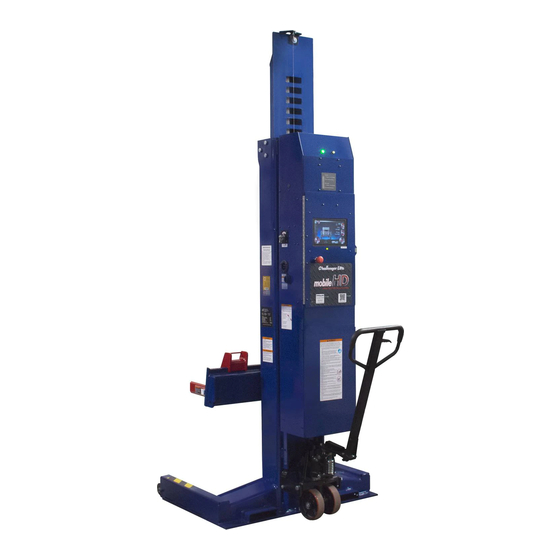Table of Contents
Advertisement
Installation, Operation &
Maintenance Manual
CLHM-140, CLHM-190, & CLHM-190W
W
P
L
S
IRELESS
ORTABLE
IFT
YSTEM
2311 South Park Rd. Louisville, Kentucky 40219
Email:
Web site:
sales@challengerlifts.com
www.challengerlifts.com
/
Office 800-648-5438
502-625-0700 Fax 502-587-1933
IMPORTANT:
READ THIS MANUAL COMPLETELY BEFORE
INSTALLING or OPERATING LIFT
Advertisement
Table of Contents

Summarization of Contents
Introduction
Owner and Operator Responsibilities
Outlines the duties and qualifications required for personnel operating the lift.
Operating Instructions
2.1 Prepare the Work Area
Details requirements for the work area, surface, clearance, and personnel.
2.2 Prepare the Vehicle
Explains how to prepare the vehicle, including tire inflation and weight distribution.
2.3 Prepare the Lift Units
Covers inspection, battery charging, and positioning of the lift units before use.
2.4 Control Box Initialization
Guides through powering on, initializing the control box, and setting radio frequencies.
2.5 Main Operation Screen
Explains the main control screen interface, buttons, and indicators for operation.
2.6 Raising/Lowering the Vehicle
Details the step-by-step procedure for raising and lowering a vehicle using the lift.
2.7 Locking the Lift System
Instructions on how to lock the lift system for security and to prevent unintended operation.
2.8 Lowering the Vehicle to the Ground
Procedure for safely lowering a vehicle when controls are not functioning.
2.9 Single/Paired Operation
Explains how to operate the lift system in single or paired modes for specific lifting tasks.
2.10 Park Mode
How to activate Park mode to mechanically support the load using down stop system.
2.11 Options
Describes accessing additional functions and buttons via the Options menu.
2.12 Tire Mode
Details the special operating mode for changing tires on dual-axle vehicles.
2.13 Control Box Shutdown and Restart Procedure
Instructions for shutting down and restarting the control box for maintenance or power saving.
Moving the Lift Unit
4.1 Moving with the Handle
Step-by-step guide on how to maneuver the lift unit using its handle.
4.2 Moving with a Forklift
Instructions for transporting the lift unit using a forklift safely.
Battery Information
5.1 Battery Type
Specifies the recommended battery type for the lift units and replacement guidelines.
5.2 Charging the Battery
Details the procedure and precautions for charging the lift unit batteries.
Battery Maintenance and Alerts
5.3 Battery Life
Discusses factors affecting battery life and recommendations for extending it.
5.4 Battery Maintenance
Outlines monthly maintenance checks for wet cell batteries, including electrolyte levels.
5.5 Critical Battery Level Detected Message
Explains the "Critical Battery Level Detected" message and the required actions.
Emergency Procedures
6.1 Emergency Stop
Describes how to use the emergency stop button to halt the lift system immediately.
6.2 Manual Lowering
Step-by-step guide for manually lowering the vehicle if controls fail.
Adjusting Carriage Width
8.1 Standard Width Models
Explains how to adjust carriage width on standard models using notches.
8.2 Wide Model
Details the adjustment mechanism for carriage width on wide models via a screw.
Maintenance Instructions
9.1 Monthly Maintenance Requirements
Lists monthly checks including oil level, labels, battery terminals, and structure.
9.2 Adding Hydraulic Fluid
Procedure for checking and adding hydraulic fluid, including fluid type and precautions.
9.3 Bleeding Air from Hydraulic Cylinder
Steps to remove air from the hydraulic cylinder if the lift feels spongy or jumpy.
9.4 Down Stop Catch Pawl Lubrication
How to lubricate the down stop catch pawl for proper operation.
Troubleshooting
General Troubleshooting Guidance
Lists common fault messages and potential solutions for control box errors.
Specific Error Resolution
Addresses specific issues like signal loss, sync errors, E-stops, and mode errors.















Need help?
Do you have a question about the CLHM-140 and is the answer not in the manual?
Questions and answers